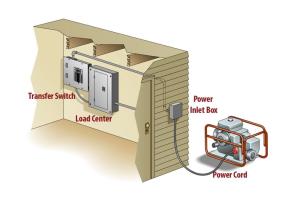Ultimate Guide to Hooking Up a Generator to Your Home: Installation & Safety Tips

-
Quick Links:
- 1. Introduction
- 2. Understanding Generators
- 3. Types of Generators
- 4. Generator Safety Guidelines
- 5. Generator Installation Process
- 6. Using a Transfer Switch
- 7. Testing Your Generator Setup
- 8. Generator Maintenance Tips
- 9. Real-World Case Studies
- 10. Expert Insights
- 11. FAQs
1. Introduction
In an age where power outages can disrupt our daily lives, having a generator at home can be a lifesaver. This comprehensive guide will take you through everything you need to know about hooking up a generator to your house safely and efficiently.
2. Understanding Generators
A generator is a device that converts mechanical energy into electrical energy for use in your home. Understanding the basics of how generators work is essential before attempting to connect one to your home.
How Generators Work
Generators produce electricity by using the principle of electromagnetic induction. When a conductor, typically copper, moves through a magnetic field, it generates an electric current. This process is the foundation of how all generators function.
3. Types of Generators
- Portable Generators: These are smaller, easy to transport, and ideal for short-term power needs.
- Standby Generators: Permanently installed and automatically activate during outages, providing seamless power.
- Inverter Generators: Known for their efficiency and quiet operation, suitable for sensitive electronics.
4. Generator Safety Guidelines
Safety is paramount when dealing with generators. Here are essential safety guidelines to follow:
- Always operate generators outdoors to prevent carbon monoxide poisoning.
- Use heavy-duty, outdoor-rated extension cords.
- Keep the generator dry and protected from moisture.
- Never overload your generator to avoid damaging appliances or the generator itself.
5. Generator Installation Process
Installing a generator involves several steps:
- Choose the Right Location: Find a dry, level area away from windows and doors.
- Prepare the Ground: Ensure the ground is stable and can support the weight of the generator.
- Install a Transfer Switch: This is critical for safely connecting your generator to your home's electrical system.
- Connect the Generator: Follow the manufacturer’s instructions to connect the generator to the transfer switch.
6. Using a Transfer Switch
A transfer switch is a crucial component that allows for the safe transfer of power from the generator to your home’s electrical system. Here’s how to install one:
- Choose the appropriate transfer switch based on your generator's wattage.
- Install the transfer switch near your main electrical panel.
- Connect the switch to the electrical panel using appropriate wiring.
- Ensure you follow all local codes and regulations.
7. Testing Your Generator Setup
Once the installation is complete, testing your setup is essential to ensure everything functions correctly.
- Turn off all breakers in your home’s electrical panel.
- Start your generator and allow it to warm up.
- Switch on the transfer switch to connect the generator to the home’s electrical system.
- Gradually turn on breakers to test powered appliances.
8. Generator Maintenance Tips
Regular maintenance ensures your generator operates efficiently when you need it most.
- Change the oil and air filters regularly.
- Keep the generator clean and free of debris.
- Test your generator monthly to ensure it is functioning properly.
9. Real-World Case Studies
Here are some examples of homeowners who successfully installed generators:
- Case Study 1: The Smith Family experienced a 72-hour power outage and were able to keep their home running with a portable generator.
- Case Study 2: The Johnsons installed a standby generator, providing peace of mind during hurricane season.
10. Expert Insights
According to electricians and safety experts, the key to a successful generator hookup is careful planning and adherence to safety protocols. “Always consult a professional if you’re unsure about electrical connections,” advises John Doe, a certified electrician.
11. FAQs
1. Do I need a permit to install a generator?
Yes, check local regulations as many areas require permits for generator installations.
2. How much does it cost to install a generator?
Costs vary widely based on the type of generator and installation complexity, typically ranging from $500 to $5,000.
3. Can I use an extension cord to connect my generator?
Yes, but ensure it is a heavy-duty, outdoor-rated extension cord to prevent overheating.
4. How often should I run my generator?
It’s recommended to run your generator monthly for about 30 minutes to keep it in good working condition.
5. What is the best fuel for a generator?
Most generators run on gasoline, but propane and diesel options are also available, depending on the model.
6. How do I know what size generator I need?
Calculate the total wattage of the appliances you want to power and choose a generator that exceeds that total.
7. Can I connect a generator directly to my electrical panel?
No, you must use a transfer switch to safely connect a generator to your home’s electrical system.
8. What is the lifespan of a generator?
With proper maintenance, a generator can last between 10,000 to 30,000 hours.
9. Are there any tax incentives for installing a generator?
Some areas offer tax credits or rebates for backup generators; check your local incentives.
10. What safety gear do I need for installation?
Wear gloves, safety goggles, and ensure you have a fire extinguisher nearby during installation.
Random Reads